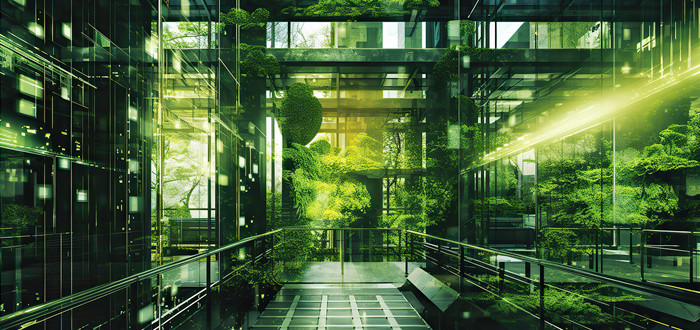How the Future of Data Centers Be Sustainable?
The Future of Data Centers: A Call to Embrace Sustainability
With the rising growth of digital usage, the challenge to manage electrical power, reduce carbon emissions, and increase energy efficiency in data centers has never been more pressing. This challenge is particularly urgent given the substantial energy demands of AI operations and training. Striking a balance between AI expansion and sustainability is crucial to prevent exceeding energy consumption.
However, the call for sustainability extends beyond mere energy conservation. It represents a strategic approach aimed at securing a more sustainable future while also maintaining competitiveness among data centers.
To address these challenges, data centers must adopt innovative green technologies that pave the way for sustainable operations. In this blog post, we'll explore various strategies contributing to this goal, followed by a closer examination of the role of networking solutions in advancing the sustainability of data center infrastructure.
The Price of AI Advancement - Rising Energy Demands
AI is driving unprecedented change worldwide, revolutionizing daily life with unparalleled convenience and efficiency. As AI adoption grows, data centers play a crucial role in meeting the escalating demands for large-scale data processing. However, this progress comes with a drawback: a surge in power and energy consumption.
According to a January 2024 report by the International Energy Agency, data centers worldwide are projected to potentially double their electricity consumption by 2026. Unlike traditional computing, AI's energy-intensive nature leads to heightened carbon emissions. Consequently, data centers face increasing pressure to innovate and address critical sustainability challenges and total cost of ownership (TCO).
While the initial investment in sustainability may seem substantial, the long-term returns are significant. Despite the upfront costs, businesses can expect to witness a marked decrease in emissions, energy expenses, and overall power usage over time. Furthermore, prioritizing sustainability can position a distinct competitive advantage within the industry.
Key Strategies for Greening Data Centers
The imperative of developing green data centers aligns with global environmental protection goals, making it more crucial than ever. Here are some examples of various strategies that data centers are adopting to move towards sustainability:
1. Green Building Design: Constructing data center buildings using eco-friendly materials and smart design techniques reduces energy usage. This includes utilizing insulation, energy-efficient windows, and natural ventilation to maintain comfortable temperatures without heavy reliance on air conditioning.
2. Renewable Energy: Powering data centers with renewable sources such as solar, wind, or hydroelectric power helps cut down carbon emissions from traditional energy sources. Many leading US colocation data centers have embraced green energy for their entire operations, with some achieving 100% reliance on renewable energy.
3. Efficient Cooling: Utilizing advanced cooling systems that consume less energy to maintain optimal temperatures within the data center is crucial. Examples include precision air conditioning and evaporative cooling, along with proper airflow management and containment systems to minimize cooling costs.
4. E-Waste Recycling: Recycling old IT equipment helps recover valuable materials and reduce waste. This involves collecting and dismantling old electronics to salvage components for reuse, contributing to sustainable resource management
5. Operational Optimization: Continuously monitoring and adjusting operations to maximize efficiency is essential. This includes optimizing airflow, adjusting temperature settings, and scheduling maintenance to reduce energy consumption and improve performance
6. Energy-Efficient Hardware: Investing in energy-efficient servers, storage, and network is crucial for sustainable computing and transferring. It reduces energy consumption per hardware unit and increase power efficiency, thereby making a significant contribution to data center sustainability efforts.
Improving Power Efficiency with Network Equipment Technologies
As we delve into networking—a cornerstone of data center operations—we uncover opportunities for enhancing power efficiency through the adoption of energy-efficient solutions. Implementing these technologies not only curtails energy consumption but also fosters the development of greener, more sustainable data centers. Here are four pivotal sustainable technologies that bolster power efficiency in network equipment:
1. 80 PLUS Certification
A variety of energy-saving labels exist in the market, offering consumers clear and accessible information to identify energy efficiency levels and promote the purchase of energy-efficient products. Among these, 80 PLUS serves as a performance certification for power supply units, offering six levels from Standard to Titanium. An 80 PLUS rating signifies that a power supply is at least 80% efficient across 20%, 50%, and 100% workloads.
UfiSpace's power supplies are certified with 80 PLUS Platinum, achieving an impressive 89% efficiency at full load.
2. Intelligent Thermal Policy
Effective thermal management is crucial to prevent overheating and maintain device temperatures within safe limits. Data center switches integrate thermal sensors and intelligent monitoring systems to achieve and sustain optimal device temperatures. These systems continuously collect data, dynamically adjusting fan speeds and make the system performance and power consumption in balance.
For instance, UfiSpace employs a Baseboard Management Controller (BMC) and temperature sensors covering most of the key components to monitor switch health conditions. Multi-level fan utilization control based on the system temperature to ensure the stable and optimal system performance.
3. Micro-venting Technology
Maintaining clear ventilation paths is critical. Strategically positioned ventilation holes on the switch's surface create optimal airflow paths, enhancing heat dissipation from internal components. These tiny apertures allow ample airflow to remove excess heat generated by critical components like CPUs, ASICs, and power supplies.
UfiSpace employs advanced micro-venting technology, reducing the wall thickness of venting hole to just 0.3mm and maximize the area of ventilation aperture. This innovation increases the venting ratio by up to 80%, facilitating efficient airflow of the system
4. Dual Airflow Management
Data centers often adopt the hot and cold aisle layout, organizing server racks in alternating rows to optimize cooling efficiency. This design segregates cold air intake from hot exhaust, maximizing the use of free cooling and reducing air-conditioning costs. Effective ventilation is essential, ensuring that warm air can escape freely while drawing in external cold air to maintain optimal temperatures within the switch.
UfiSpace takes the requirement into consideration and optimizes the thermal design to support both directions of airflow incorporating with front-to-back or back-to-front fan and PSU modules.
Sustainability is not just a future initiative; it has become a crucial global concern. The adoption of green data centers can shift the tech industry’s role from contributing to the problem to contributing to the solution. A sustainable future requires a new mindset and action from everyone. The future is already upon us, urging the adoption of innovative and green practices to build a more sustainable future.
About the Author
 |
UfiSpace Marketing Team |

